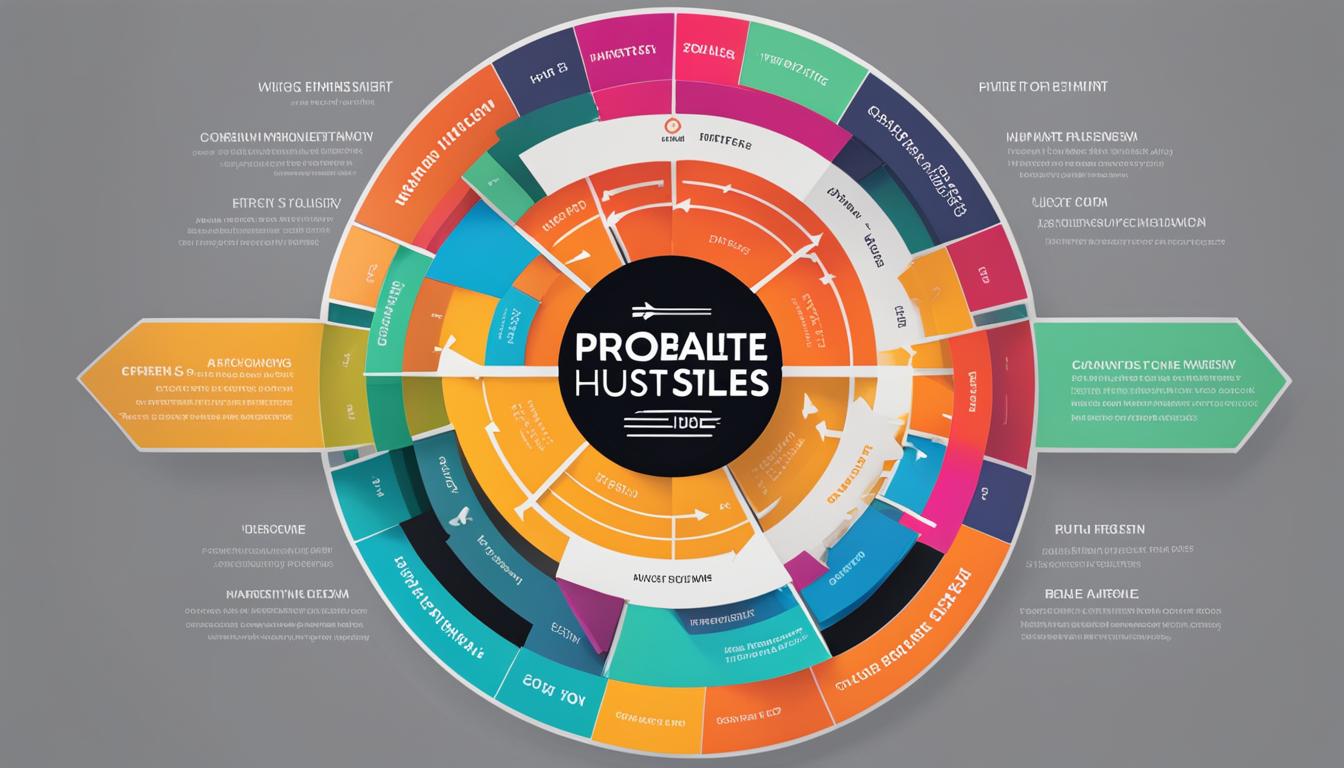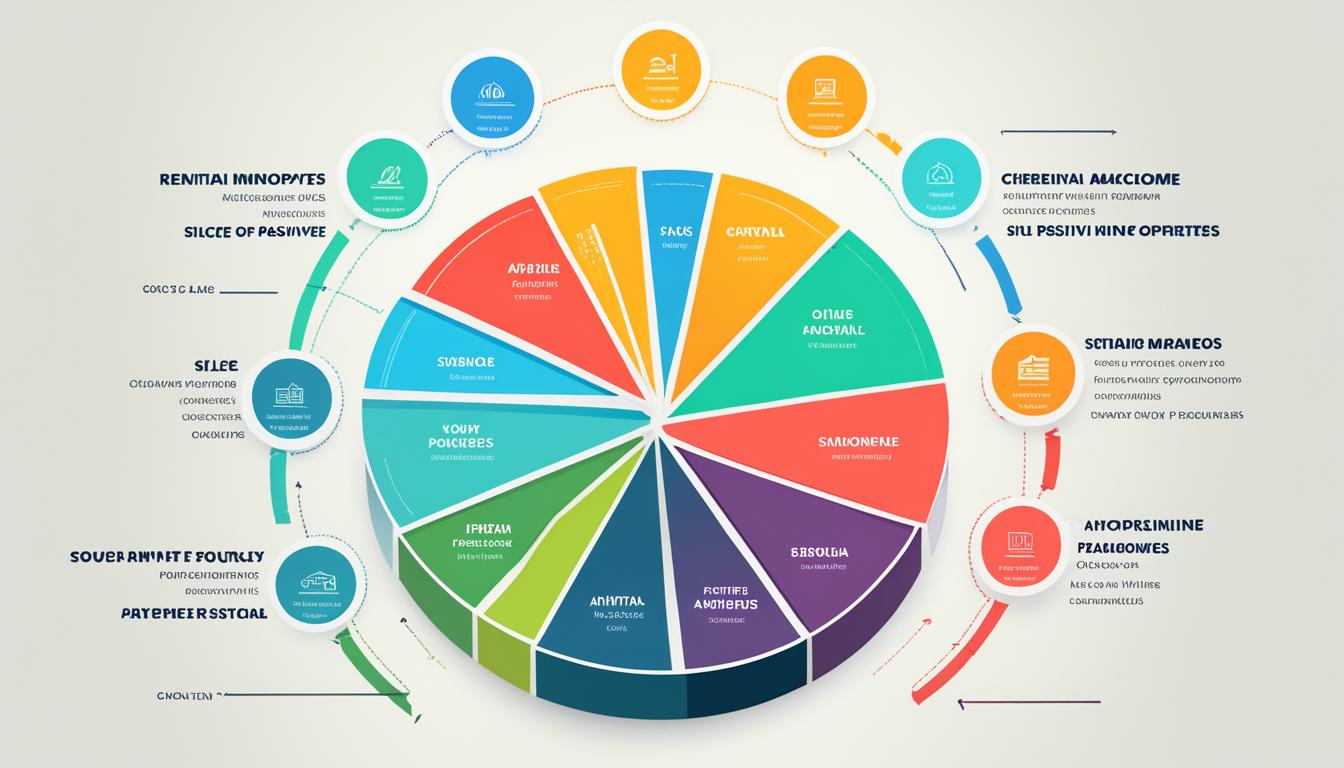Welcome to our step-by-step guide on how to write a business plan. Whether you’re just starting or looking to grow your business, a well-crafted business plan is essential. It not only outlines your financial goals but also provides a roadmap for success over the next three to five years.
Writing a business plan may seem daunting, especially for beginners. But with the right guidance and resources, you can create a powerful plan that attracts potential investors and partners.
In this guide, we’ll take you through each step of the process, from crafting the executive summary to developing financial projections. We’ll provide examples, templates, and expert tips to help you navigate each section of your business plan with ease.
Ready to get started? Let’s dive in and create a winning business plan!
Key Takeaways:
- Writing a business plan is crucial for setting financial goals and attracting investors.
- A well-crafted business plan provides a roadmap for your business’s success.
- Follow our step-by-step guide to create an effective business plan.
- Utilize templates, examples, and expert tips to enhance your plan.
- Stay organized and focused on each section to ensure a comprehensive plan.
Writing the Executive Summary
The executive summary is a crucial section of your business plan. It serves as an introduction to your business and provides a concise overview of your company, its products or services, and future growth plans. This section plays a vital role in creating a strong first impression and capturing the interest of potential investors or partners.
When writing an executive summary, it’s important to keep it concise and focused. Think of it as your elevator pitch, where you need to make a strong case for your business in a limited space. Here are some key elements to include:
- Mission Statement: Clearly articulate your company’s purpose and the problem it aims to solve.
- Brief Description: Provide a summary of your products or services, emphasizing their unique features or competitive advantages.
- Financial Growth Plans: Outline your goals for revenue growth and profitability, including any specific strategies or milestones you plan to achieve.
While the executive summary is typically written first, it can be easier to craft it after completing the other sections of your business plan. This way, you’ll have a better understanding of your business’s entire narrative and can effectively summarize it in the executive summary.
Writing a compelling executive summary requires striking a balance between providing enough information to generate interest and keeping it concise enough to hold the reader’s attention. Consider using bullet points or short paragraphs to convey key details effectively. It’s also important to proofread and edit your executive summary to ensure clarity and coherence.
You only have one chance to make a strong first impression, and the executive summary of your business plan plays a significant role in that. Craft it carefully, highlighting the most compelling aspects of your business, and entice readers to explore the rest of your plan.
Components of an Effective Executive Summary
| Component | Description |
|---|---|
| Mission Statement | A clear and concise statement of your company’s purpose and values. |
| Description of Products or Services | A brief overview of your offerings, emphasizing any unique features or advantages. |
| Financial Growth Plans | Highlight your revenue and profitability goals, along with key strategies to achieve them. |
Describing Your Company
In this section, you will provide details about your company, including its registered name, key personnel, and business structure. Highlight the unique skills or expertise among your team members and explain the history and nature of your business. This section sets the stage for the following sections that focus on your goals and products/services.
When describing your company in a business plan, it’s important to paint a clear picture of who you are and what you do. Start by providing your company’s registered name, which should be the official name under which you operate.
Next, introduce the key personnel who play a pivotal role in your company’s success. Highlight their qualifications, experience, and expertise, emphasizing any unique skills or knowledge they bring to the table. This will demonstrate to potential investors and partners that your team is capable of achieving your business objectives.
Additionally, include information about your business structure, whether it’s a sole proprietorship, partnership, corporation, or limited liability company (LLC). Describe how the company is legally organized and how ownership is distributed among partners or shareholders.
When discussing your business history, provide a concise but informative overview. Talk about how the company was founded, the inspiration behind it, and any significant milestones or achievements along the way. This will help give investors and partners a sense of your business’s journey and the progress it has made.
To enhance the visual appeal and clarity of this section, consider incorporating a table that outlines the key personnel and their roles within the company. This will provide a quick reference for readers and present the information in a structured format.
| Name | Title | Expertise |
|---|---|---|
| John Smith | CEO | Strategic planning, business development |
| Jane Johnson | CFO | Financial management, budgeting |
| Michael Lee | CTO | Technology innovation, product development |
Stating Your Business Goals
Your business goals are the guiding force behind your business plan. This section outlines your objectives, both in the short-term and long-term and serves as a roadmap for the future growth and success of your company. Whether you’re seeking financing or investment, stating your business goals is essential to demonstrate your vision and the potential of your venture.
Start by clearly defining your objectives. What do you aim to achieve with your business? Do you have specific revenue targets in mind? Are there particular markets or customer segments you want to target? Your goals should be ambitious, yet realistic.
To effectively communicate your business goals, including an objective statement in your business plan. This statement provides a concise overview of what you hope to accomplish and sets the tone for the rest of your plan. It should be clear, compelling, and aligned with your overall vision for the company.
Short-Term Goals
Short-term goals are milestones that you plan to achieve within the next one to two years. They should be specific, measurable, attainable, relevant, and time-bound (SMART goals).
In this section, outline the short-term goals that will propel your business forward. For example, you might set targets for customer acquisition, sales growth, or product development. These goals will serve as stepping stones towards your long-term vision.
Long-Term Goals
Long-term goals are the broader objectives that will shape the future of your business. These goals typically extend beyond the next few years and encompass your ultimate vision for success.
In this section, articulate your long-term goals, such as market expansion, international growth, or becoming an industry leader. These goals should inspire and motivate your team, as well as attract potential investors who share your vision.
Growth Targets
Growth targets are the specific metrics by which you will measure your success. These targets can include revenue growth, market share, customer acquisition, or any other key performance indicators that are relevant to your industry.
When stating your growth targets, be specific and provide a clear roadmap for achieving them. Break down your targets into manageable milestones and set deadlines for each. This demonstrates your strategic thinking and shows that you have a solid plan in place to achieve your goals.
Financing
Financing is often a critical factor in achieving your business goals. Whether you’re seeking a loan, investment, or other forms of financing, you need to clearly explain why you need the funds and how they will contribute to your growth.
In this section, outline your financing needs and how the funds will be utilized. Explain how the investment will support your business goals and help you reach your growth targets. This is an opportunity to showcase the potential return on investment and demonstrate your financial acumen.
By clearly stating your business goals, you provide investors, lenders, and other stakeholders with a clear understanding of your vision and the potential of your business. This section sets the stage for the subsequent sections of your business plan, where you will delve into the strategies and tactics that will help you achieve your goals.
Describing Your Products and Services
When it comes to the success of your business, a clear and compelling description of your products and services is essential. This section provides an opportunity to showcase what sets your offerings apart from the competition and demonstrates their value to potential customers. To effectively describe your products and services, consider the following:
Product/Service Explanation
Begin by providing a thorough explanation of what your products or services do. Highlight their features, benefits, and unique selling points. Use descriptive language that appeals to your target audience and communicates how your offerings can solve their problems or fulfil their needs.
Pricing Model
Clearly outline your pricing model, including any pricing tiers or packages available. Explain the value proposition behind your pricing structure and how it compares to other competitors in the market. This helps potential customers understand the affordability and value for money they can expect when choosing your products or services.
Target Customers
- Identify your target customers, including their demographics, psychographics, and buying behaviours. This helps you tailor your marketing efforts and product development to meet their specific needs and preferences.
- Describe why your offerings are particularly well-suited for your target customers. Highlight any unique features or benefits that address their pain points or desires.
Supply Chain
Explain the supply chain for your products or services. Detail the sources of your raw materials or components, any manufacturing or production processes involved, and how your offerings are delivered to customers. This provides transparency and helps build trust with potential customers, who may appreciate knowing the origin and quality of the products or services they are considering.
Sales Strategy
- Outline your sales strategy for promoting and selling your products or services. Describe the channels you utilize, such as direct sales, e-commerce platforms, retail partnerships, or a combination of these.
- Highlight any specific sales tactics or initiatives you employ to attract customers and drive conversions. This could include promotional offers, referral programs, or influencer marketing.
Distribution Strategy
Detail how your products or services are distributed to customers. Discuss your distribution channels, such as direct shipping, third-party logistics providers, or retail partnerships. Explain the advantages of your chosen distribution strategy and how it benefits both your business and customers.
Remember, the way you describe your products and services can significantly impact potential customers’ perception and purchase decisions. Be persuasive, highlighting the unique qualities and advantages of your offerings. Paint a compelling picture that resonates with your target audience, leaving them eager to try what you have to offer.
Conducting Market Research
When it comes to attracting lenders and investors, it’s essential to demonstrate the unique value your product or service brings to the market. This is where conducting thorough market research becomes crucial. By diving deep into your industry, you can identify key competitors, assess their strengths and weaknesses, and position your offering to stand out.
To begin, start by analyzing your market landscape and competitors’ offerings. Investigate their pricing strategies, marketing tactics, and target audience. This will help you carve out your unique selling proposition (USP), the factor that distinguishes your business from the competition. Whether it’s innovative features, superior quality, or unmatched customer service, your USP helps you attract and retain customers.
If you’ve identified an underserved market niche, now is the time to highlight it in your market analysis section. Showcase the potential and demand for your product or service within this segment. Explain how your business will fill the existing gap and cater to the needs of this underserved market.
Remember, market research should go beyond just identifying competitors. It also involves understanding your target customers – their preferences, pain points, and buying behavior. This insight will allow you to tailor your marketing and sales strategies to effectively reach and engage your target audience.
| Competitor | Strengths | Weaknesses |
|---|---|---|
| Competitor A | Excellent brand reputation | Outdated technology |
| Competitor B | Wide distribution network | High price points |
| Competitor C | Strong customer loyalty | Limited product range |
In conclusion, by conducting thorough market research and competitor analysis, you can uncover valuable insights that will shape your business strategy. Understand your target market, identify your unique selling proposition, and position your business to cater to underserved needs. This knowledge will not only impress potential lenders and investors but also give your business a competitive edge in the market.
Outlining Your Marketing and Sales Plan
In this section, you will dive into the details of your marketing and sales plan, outlining effective strategies to persuade customers to buy your products or services. The key to successful marketing lies in attracting and retaining customers, building customer loyalty, and encouraging repeat business. By implementing a well-crafted marketing strategy, you can position your business for long-term growth and profitability.
Developing a Persuasive Marketing Strategy
Begin by outlining your marketing strategy, which encompasses the overall approach and tactics you will use to promote your products or services. Consider the following factors:
- Identify your target audience: Define the specific group of customers who are most likely to be interested in your offerings. Conduct market research to gain insights into their needs, preferences, and behaviour.
- Select appropriate marketing channels: Determine the most effective channels to reach your target audience. This may include online platforms, social media, email marketing, content marketing, traditional advertising, or a combination of these.
- Create compelling promotional activities: Craft persuasive messages and compelling offers to capture the attention of your target customers. Highlight the unique features and benefits of your products or services to differentiate yourself from competitors.
- Utilize customer acquisition tactics: Implement strategies to attract new customers, such as referral programs, partnerships, or special promotions. Leverage your existing customer base to generate positive word-of-mouth and expand your reach.
Fostering Customer Loyalty and Repeat Business
To ensure the long-term success of your business, it’s crucial to focus on fostering customer loyalty and encouraging repeat business. Consider the following strategies:
- Provide exceptional customer service: Deliver a memorable customer experience by addressing customer needs promptly and professionally. Seek feedback and continually strive to exceed expectations.
- Build strong relationships: Establish a personal connection with your customers through personalized communication and follow-ups. Maintain regular contact to stay top-of-mind and nurture ongoing relationships.
- Create loyalty programs: Implement loyalty programs or rewards systems to incentivize repeat purchases and customer referrals. Offer exclusive discounts, perks, or VIP benefits to loyal customers.
- Engage through content and social media: Share valuable content, tips, and advice through your website, blog, or social media channels. Engage with your audience, respond to comments, and build a community around your brand.
By focusing on building strong customer relationships, providing exceptional service, and implementing effective marketing strategies, you can create a solid foundation for customer loyalty and repeat business.
| Marketing Channel | Advantages | Disadvantages |
|---|---|---|
| Social Media | Wide reach, cost-effective, targeting options | Can be time-consuming to manage |
| Email Marketing | Direct communication, personalized messaging | Potential for spam filters, opt-out rates |
| Content Marketing | Builds brand authority, attracts organic traffic | Requires consistent content creation |
| Traditional Advertising | Wide audience reach, brand recognition | Higher costs, less targeted |

Performing a Business Financial Analysis
If you’re an existing business, conducting a thorough financial analysis is crucial to understanding the financial health of your company. This analysis involves examining various financial statements, such as income statements, balance sheets, and cash flow statements, to gain insights into your business’s performance and profitability. By evaluating key financial metrics and ratios, you can assess the overall financial well-being of your business.
Let’s take a closer look at the essential components of a business financial analysis:
Income Statements:
An income statement, also known as a profit and loss statement, provides a summary of your company’s revenues, expenses, and net income over a specific period. It highlights your business’s ability to generate profits and reveals any underlying trends or patterns in your revenue streams and expenses.
Balance Sheet:
A balance sheet is a snapshot of your company’s financial position at a specific point in time. It encompasses your business’s assets, liabilities, and shareholders’ equity. This statement allows you to evaluate the liquidity and solvency of your business, as well as assess its ability to meet short-term and long-term financial obligations.
Cash Flow Statement:
A cash flow statement tracks the inflows and outflows of cash within your business during a particular period. It provides insights into your company’s cash flow from operating activities, investing activities, and financing activities. Analyzing the cash flow statement helps you assess the cash-generating capacity of your business and its ability to meet ongoing expenses and investment needs.
When performing a business financial analysis, it’s essential to consider key financial health indicators and profitability ratios. These metrics help you gauge the overall financial strength and performance of your business. Some important ratios include:
- Net Profit Margin: This ratio indicates the percentage of revenue that translates into net profit. It measures your business’s overall profitability.
- Current Ratio: The current ratio assesses your business’s liquidity and ability to meet short-term obligations. It compares current assets to current liabilities.
- Accounts Receivable Turnover Ratio: This ratio reflects how quickly your business collects payments from customers. It measures the efficiency of your credit policies and collection efforts.
To present your financial analysis effectively, consider using charts, graphs, and tables with key financial data. Visual representations can help convey complex financial information concisely and make it easier for stakeholders to understand and interpret.
A visually appealing and relevant image like the one above can complement your financial analysis, providing a visual representation of the financial information being discussed.
Remember, a comprehensive financial analysis offers valuable insights into your company’s financial health and can guide strategic decision-making. By examining income statements, balance sheets, cash flow statements, and profitability ratios, you’ll gain a deeper understanding of your business’s financial performance and identify areas for improvement.
Making Financial Projections
If you’re seeking financing or investors for your business, creating accurate and realistic financial projections is crucial. These projections provide insights into your business’s potential profitability and help investors assess the return on investment. They also serve as a roadmap for your business’s financial performance over three years.
To create financial projections, you need to estimate your sales, expenses, and profit for each month or quarter. These estimates should be based on a thorough analysis of your past financial statements. By examining your historical data, you can identify patterns and trends that will help you make more accurate projections for the future.
“Accurate financial projections are essential for securing financing and attracting investors.”
When making financial projections, it’s important to set realistic but ambitious goals for your business. Consider factors such as market trends, competitive landscape, and your business’s growth potential. By carefully analyzing these factors, you can project sales estimates that align with your business’s growth strategy.
Additionally, you should estimate your expenses accurately, taking into account overhead costs, production costs, marketing expenses, and any other operational expenses. By forecasting your expenses, you can determine the financial resources required to support your business’s growth.
Finally, calculating the projected profit is essential for assessing the financial viability of your business. By subtracting your projected expenses from your projected sales, you can estimate the potential profit your business can achieve over three years. This information is valuable for both internal decision-making and attracting external investors.
Here is an example of a three-year financial projection table:
| Year | Sales | Expenses | Profit |
|---|---|---|---|
| Year 1 | $500,000 | $400,000 | $100,000 |
| Year 2 | $750,000 | $550,000 | $200,000 |
| Year 3 | $1,000,000 | $700,000 | $300,000 |
By presenting your financial projections in a clear and organized manner, you can demonstrate your business’s potential for growth and profitability.

Conclusion
Writing a business plan is an essential step in starting and growing a successful business. It provides a roadmap that helps you navigate the challenges and make informed decisions. However, there are some common mistakes that you should avoid to ensure your business plan is effective.
Firstly, make sure to avoid over-optimism in your projections. While it’s important to demonstrate the potential of your business, be realistic and back up your assumptions with thorough research and analysis. Remember, investors and lenders value credibility and accuracy.
Secondly, proofread your business plan for errors. Simple spelling or grammatical mistakes can create a negative impression and undermine the professionalism of your plan. Take the time to review and edit your document before sharing it with others.
Lastly, take advantage of the resources available to support you in writing a business plan. Organizations like SCORE and Small Business Development Centers offer valuable guidance and templates that can help you structure your plan effectively. These resources provide expert advice and insights that can enhance the quality and impact of your business plan.
FAQ
How do I write a business plan?
Writing a business plan involves outlining your financial goals and explaining how you’ll achieve them. This step-by-step guide will take you through the process, from the executive summary to financial projections.
What is the executive summary of a business plan?
The executive summary serves as your elevator pitch and should include a mission statement, a brief description of your products or services, and a summary of your financial growth plans.
What should I include in the company description section?
In the company description section, provide details about your registered name, key personnel, and business structure. Highlight unique skills among your team members and explain the history and nature of your business.
How do I state my business goals in the business plan?
The business goals section should outline your objectives, short-term and long-term. Explain why you need financing or investment, how it will help your business grow, and how you plan to achieve your growth targets.
What should I include in the product and service description?
In the product and services description section, provide a detailed explanation of your products and services. Include how they work, your pricing model, your target customers, your supply chain, and your sales and distribution strategies.
How do I conduct market research for my business plan?
Conduct market research to identify your competitors, their strengths and weaknesses, and how you can differentiate yourself. If you’re targeting an underserved market, highlight that in your market analysis.
How do I outline my marketing and sales plan?
In the marketing and sales plan section, explain how you plan to persuade customers to buy your products or services. Outline your marketing strategy, customer acquisition tactics, and how you will develop customer loyalty.
What financial analysis should I include in my business plan?
If you’re an existing business, include financial statements such as income statements, balance sheets, and cash flow statements. Highlight key financial metrics and use charts and graphs to present your financial information effectively.
How do I make financial projections for my business plan?
Provide monthly or quarterly projections of sales, expenses, and profits over three years. Analyze your past financial statements before making projections and set realistic but ambitious goals for your business’s financial performance.
What are some tips for writing a business plan?
Avoid over-optimism, proofread your plan for errors, and use free resources like SCORE and Small Business Development Centers for guidance. Remember to include all the necessary components, such as an executive summary, company description, market analysis, financial plans, and goals.





